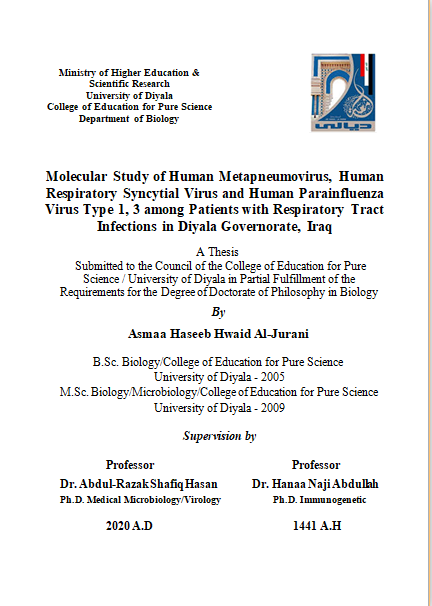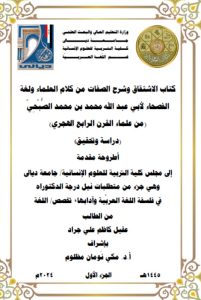Summary
Globally, viral respiratory infections are an important cause of morbidity and mortality and represent a serious threat to human health, among these viruses Human Metapneumovirus (HMPV) which is an emerging respiratory pathogen that was first described in 2001, which is quite similar to the Human Respiratory Syncytial Virus (HRSV) regarding symptoms and clinical signs, Human Parainfluenza viruses type 1 and 3 (HPIV-1 and HPIV-3) are other respiratory pathogens. These viruses are responsible for a wide range of upper and lower respiratory tract infections.
The present study is a cross-sectional study conducted at Baqubah Teaching Hospital and Al-Batool Teaching Hospital for Maternity and Children plus outpatient clinics in Diyala governorate, Iraq, for the period from 16/January/2018 to 30/October/2019. The objects of the current study included, exploration of the prevalence rates of HMPV, HRSV and HPIV type 1 and 3 among patients clinically presented with respiratory tract infections, determination the co-infection with two or more of the respiratory viruses included in this study, figure out the associated socio-demographic risk factors, furthermore, determination the seasonal distribution and genetic diversity (predominant genotype) of the local circulating HMPV and HRSV strains by analyzing the sequencing of nucleotides and phylogenetic tree of (G) and (F) genes of HMPV and genetic subgrouping of (F) gene of HRSV and finally a genetic comparison of the local HMPV isolates with the others from different countries through the multiple and pairwise alignment of these isolates with international isolates available in the GeneBank database.
Three hundred and twenty-three patients from those clinically suspected as having respiratory tract infections RTIs (children, adults and elderly) were included. The study was extended over two seasons; 185 patients were included in the first season (January, February, March, April, May) and 138 in the second season (November and December). Three different respiratory specimens were collected including nasopharyngeal swabs, nasal swabs and throat swabs. Human privacy was respected through obtaining official written approval from the Research Ethics Committee in Diyala Directory of Health and specimen’s collection was done under the direct supervision of specialized doctors and practitioners after approval of the study participants or their parents. Specimens were analyzed by using real-time PCR (RT-PCR/qPCR) assay for (HMPV, HRSV and HPIV-1/HPIV-3) and conventional PCR assay for (HMPV and HRSV). Genotyping for the positive samples of HMPV and genetic subgrouping of HRSV was performed.
The results showed that HMPV single infections was detected in 30(9.3%) and a co-infection with HPIV-3 was (n = 1) that had the same clinical manifestations and single infection with the HRSV was detected in 15(4.6%) and a co-infection with HPIV-3 was (n = 1), while HPIV-3 alone was detected in 17 (5.3%) and no HPIV-1 infections were detected. The highest positivity rates of HMPV appeared in specimens collected during November and December, season II with a significant difference compared to other months (50%, P= 0.0001). Obviously, the highest HMPV positivity rate was detected among nasal sinus swabs with a statistically significant difference compared to nasopharyngeal and throat swabs (96.7%, P=0.0001). HRSV positivity rate was significantly higher in the first season compare to the second season (93.3% versus 6.7%, P=0.004), March compared to other months of the year shows a highest detection rate (P=0.012), HRSV was detected in (53.3%) of throat swabs which were significantly higher compared to nasopharyngeal swabs (40.0%) and nasal sinus swabs (6.7%) (P=0.003). HPIV-3 positivity rate during the season I was higher compared to season II was (64.7% versus 35.3%) (P=0.525) and November showed the highest detection rate (29.4%, P=0.340); however, the difference was failed to reach the statistical significance for both. Additionally, throat and nasal swabs proved effectiveness in showing the highest positive rate of the HPIV-3 (64.7%, 35.3%) respectively. Regarding the age-related positivity of HMPV, HRSV and HPIV-3 the infections were highest among children under 5 years of age (86.7%, 53.3%, 82.4%) respectively. Clinical pictures most closely related to the higher positivity rate of HMPV and HPIV-3 were Bronchiolitis/bronchitis (86.7%, 88.2%) with a statistically significant difference (P=0.001, 0.003).
Phylogenetic analysis of HMPV attachment glycoprotein (G) gene showed that of the 28 Iraqi isolates collected during the second season, 15 of these isolates belong and cluster within genotype (B), sub-lineages (B2) circulated in this region. These isolates were registered with the (GeneBank) at the National Center for Biotechnology Information (NCBI) and a global accession number was obtained. Multiple sequence alignment showed high homologies estimated by (98% and 97%) have been observed between Iraqi isolates (MN178608.1, MN178613.1, MN178615.1, MN178617.1, MN178606.1, MN178607.1, MN178619.1, MN178620.1) and HMPV genotype B, sub-lineages B2 prevalent in Spain (GenBank acc. KX829167.1) and Malaysia (GenBank acc. KU320936.1), in the other hand, pairwise sequence alignment showed homologies estimated by (96%) between Iraqi strains (MN178609.1, MN178610.1, MN178611.1, MN178612.1, MN178614.1, MN178616.1, MN178618.1) and Malaysian strains (GenBank acc. KU320936.1). Significant genetic variation in the sequencing of nucleotides and amino acids was observed in the (G) gene, alignment of nucleotides and amino acids sequences of the (G) gene and phylogenetic tree demonstrated that three distinct HMPV variants within the same (B2) sub-lineage were detected as a result of frameshift variations (insertion mutations), the subgroup one included (MN178608.1, MN178613.1, MN178615.1, MN178617.1); the subgroup two included (MN178606.1, MN178607.1, MN178619.1, MN178620.1); and subgroup three included (MN178609.1, MN178610.1, MN178611.1, MN178612.1, MN178614.1, MN178616.1, MN178618.1).
The study concluded that HMPV has an important role as a viral cause with a high rate of RTIs in the Diyala community, especially among children followed by the importance of HRSV and HPIV-3 as respiratory pathogens. Seasonal variation of HMPV can be observed in this study and predominance of the prevalence of HMPV (B) genotype, (B2) sub-lineage compared to other viruses under study. Emerging HMPV strains are continually evolving.




